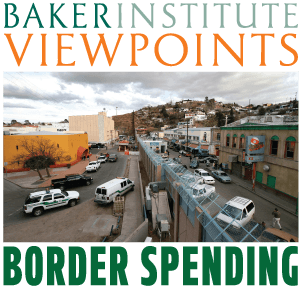In an effort to secure bipartisan support for immigration reform, a bill recently passed by the Senate includes a dramatic increase in border security spending of at least $40 billion. This funding provides for the addition of 18,000 new Border Patrol agents, 700 miles of fencing and expanded use of drones on the U.S.-Mexico border. Facing financial losses from the withdrawal of U.S. forces from Iraq and Afghanistan, the nation’s largest private military contractors are now vying for profitable contracts on the U.S.-Mexico border. Critics have argued that increasing border security spending will further militarize the border and exacerbate existing budget deficits. In this Baker Institute Viewpoints series, six experts respond to the question: What are the implications of expanding border security? Their analyses cover a range of issues — including the legality of drones, the environmental impact of constructing border fencing and the politics of bipartisan compromise — and reveal the complex unintended consequences of increasing spending on border security.
Read other posts in this series:
- U.S. border security spending: Too much, too late? by Robert Bunker, senior fellow with Small Wars Journal — El Centro
- The broader implications of enhancing border surveillance capabilities by Geoffrey Corn, professor at the South Texas College of Law
- Achieving border security: A matter of money or competency? by Guadalupe Correa-Cabrera, assistant professor and chair of the government department of the University of Texas at Brownsville
- Securing the “hyperborder”: U.S.-Mexico border security investments by John Sullivan, lieutenant in the Los Angeles County Sheriff’s Department and senior fellow with Small Wars Journal — El Centro
- Less fence, more task force by Nathan Jones, postdoctoral fellow in drug policy
The immigration bill recently passed in the Senate assigns nearly $50 billion to increase border security – a border “surge.” This unprecedented deployment of resources includes 20,000 additional Border Patrol agents; new technology such as drones, sensors and cameras; and hundreds of miles of wall along the border. Proponents reason that the border surge will bring order to the region and stem the flow of undocumented immigrants into the United States. However, this expenditure could lead to multiple unintended consequences that should give pause to anyone considering it.
This surge aims to secure the border region, but it is largely misguided because it misses the point. The problem with the border is that neither Mexico nor the United States has ever wanted to negotiate a comprehensive joint agreement to manage the border. Instead both countries have handled it with unilateral actions and postures reminiscent of a hostile rather than a heavily integrated border. What the border needs is not additional military-style tactics to manage flows, but a strategy that acknowledges that the financial goods, services and labor markets of North America are integrating at a pace that has made the unilateral and nationalistic stances of both countries obsolete. This disparity between the reality of the border and the responses of both countries has led to a series of structural problems that have made the border unlivable, chaotic and increasingly violent (at least on the Mexican side). By adding military force to the border, the United States is bound to pay not only the heavy price of $50 billion but also the opportunity cost of what could be gained by having an efficient and forward-looking border management system.
Additionally, the bill ignores the reality that most of what crosses the border — including labor — neither originates at the border nor intends the border to be its final destination. The bill fails to acknowledge this and instead targets unauthorized border flows with militaristic tactics in what is fundamentally a supply-side strategy.
The results of this approach are predictable. First, it will fail to stop the flow of illegal drugs. Drug traffickers do most of their cross-border trafficking at ports of entry, underground or over water. They are flexible and respond swiftly to any move by the U.S. government, including heavily militarized investment on the border. Second, since the bill fails to provide for the integration of labor markets in North America, migrants will continue to cross illegally, and fatalities will only increase as they take greater risks to cross the border. Those who cross the border successfully will find themselves part of an exploited class within the United States, unable to exercise any rights of complaint if they are mistreated at the workplace. This could contribute to the problem of human trafficking within the U.S. by making it more profitable for traffickers. Third, the incidents of Border Patrol agents firing on or beating migrants will also increase as the agency acquires the roguish outlook that it is not just the law but national security that lies in its hands. Fourth, the $50 billion will add to the U.S. budget deficit at a time when the nation can hardly afford any more federal spending. Fifth, this money will likely create a new border security industrial complex, giving companies, consultants and services salespeople a huge incentive to lobby officials in Washington in order to turn a profit and prevent lawmakers from moving toward a more rational border management policy with Mexico. Sixth, tightening border security will only drive up the costs of doing business across the border — business that could potentially create enormous prosperity in a region long marked by poverty. Billions of dollars in lost economic opportunities are already visible everywhere, such as the long wait times for border crossings that discourage buyers and sellers on both sides. Finally, the traffic of tens of thousands of border patrol agents and vehicles, technological deployment and a wall that splits asunder entire ecosystems will wreak immense environmental damage on the border region and create prime conditions for climatic and epidemic crises.
It seems likely that things will get worse on the border before they get better. There is no political will in Washington (or Mexico City) to view the border as a binational problem rather than two separate national problems. The situation is worsened by strategies that securitize — and consequently militarize — the border region. No rational policy is within sight in the years to come.
 Tony Payan is the Baker Institute’s fellow in Mexico studies and director of the Mexico Center.
Tony Payan is the Baker Institute’s fellow in Mexico studies and director of the Mexico Center.
